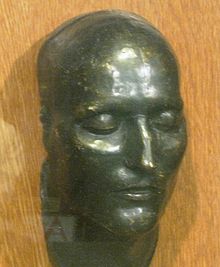- Napoleon's Death Mask
-
Napoleon's Death Mask is a marble cast mold of the face of Napoleon Bonaparte, Emperor of the French. Much mystery and controversy surrounds the origins and whereabouts of the most original cast moulds. There are only four genuine death masks known to exist.[1]
Contents
Origins and history
Napoleon's original death mask was created on May 7, 1821,[2] a day and a half after Napoleon Bonaparte died on the island of St. Helena at age 51.[2] Surrounding his deathbed were doctors from France and the UK.
During the time of Napoleon, it was customary to cast a death mask or mould of a great leader who had recently died.[2] A mixture of wax or plaster was carefully placed over Napoleon's face and removed after the form had hardened. From this impression, subsequent copies were cast.
Myths and legends
- It is commonly believed that Dr. Antommarchi (one of the many doctors that encircled Napoleon's deathbed) cast the original "parent mould",[2] which would spawn many bronze copies. This is false. The surgeon Francis Burton, of Britain's Sixty-Sixth Regiment at St. Helena, cast the original mould. It was Dr. Burton, too, who presided at the emperor's autopsy.[2] Antommarchi obtained from his British colleagues a secondary plaster mould from Burton's original cast. With his own mould, Antommarchi later made, in France, copies of the death mask in both bronze and plaster.[2]
- It is believed that Madame Bertrand, Napoleon's attendant, managed to steal part of the cast, leaving Burton with just the ears and back of the head. He took Bertrand to court in an attempt to get the cast back, but failed. A year later Madame Bertrand gave Antommarchi a copy of the mask, from which he had several copies made. One of these he sent to Lord Burghersh, the British envoy (representative) in Florence, asking him to pass it to the famous sculptor, Antonio Canova. Unfortunately Canova died before he had time to use the mask and instead the piece remained with Burghersh. The National Museums Liverpool version, cast by E. Quesnel, is thought to be a descendant of that mask.[3]
- Some people believe that Dr. Antommarchi lived in Cuba for a short period of time and contracted yellow fever. While there he lived on his cousin's coffee plantation and became close to General Juan de Moya. Before Dr. Antommarchi died, he made General Moya a death mask from his mould. It is believed that the mask still resides in The Museum in Santiago de Cuba, province of Oriente, where there was a large group of French immigrants that established coffee plantations in the high mountains of the Sierra Maestra..[4]
- New Orleans authorities moved their death mask in 1853. During the tumult that accompanied the Civil War, the mask disappeared. A former city treasurer spotted the mask in 1866 as it was being hauled to the dump in a junk wagon. Rather than return the mask to the city, the treasurer took the mask home and put it on display there. Eventually Napoleon's death mask wound up in the Atlanta home of Captain William Greene Raoul, president of the Mexican National Railroad. Finally, in 1909, Napoleon's death mask made its way back to New Orleans. Captain Raoul read a newspaper article about the missing mask and wrote to the mayor of its whereabouts. In exchange for suitable acknowledgement, Raoul agreed to donate the death mask to New Orleans. The mayor transferred the mask to the Louisiana State Museum that year.[5]
Death Mask locations
- In 1834, Dr. Antommarchi traveled to the United States, visited New Orleans, and presented that city with a bronze copy of the mask. The French doctor also gave a painted plaster copy to a colleague in New Orleans, Dr. Edwin Smith.[2] Following the death of Dr. Smith, the plaster mask was given to the family of Captain Francis Bryan, a resident of St. Louis, Missouri. In 1894, Bryan donated this mask to his alma mater, the University of North Carolina at Chapel Hill.[2]
During its first years in Chapel Hill, Napoleon's plaster face was displayed as a curio on a table in the office of UNC President George T. Winston. The death mask was later transferred to the university library and ultimately found its way to the library's North Carolina Collection. Today, the mask remains in remarkably good condition. The only visible damage to it is a chip above the emperor's upper lip. This damage occurred in 1907, when a janitor at the university overturned the mask while dusting it. On the underside of the mask is the handwritten inscription: "Dr. Edwin B. Smith's head of Nap.n" and "Presented to Dr. Smith by N[ap's] Phys'n. Dr.Ant[tommarchi]." Also written on the bottom of the mask is "Tete d'Armee" (Head of the Army), reportedly the last words uttered by Napoleon.[2]
- Dr. Antommarchi moved to Cuba in 1838. While there, he lived on his cousin's coffee plantation and became close to General Juan de Moya. Before Dr. Antommarchi died, he made General Moya a death mask from his mould. It is believed that the mask still resides in the Museum in Santiago de Cuba, province of Oriente, where there were many French immigrants who established coffee plantations in the high mountains of the Sierra Maestra.[4]
References
- ^ "New Orleans Cabildo.". Fondation Napoléon. http://www.napoleon.org/en/magazine/museums/files/The_Cabildo1.asp. Retrieved 2008-08-04.
- ^ a b c d e f g h i "Death Mask of Napoleon". University of North Carolina. http://www.lib.unc.edu/ncc/gallery/napo.html. Retrieved 2008-08-04.
- ^ "Napolean's death mask". Liverpool Museums. http://www.liverpoolmuseums.org.uk/nof/top/deathmask.html. Retrieved 2008-08-04.
- ^ a b Gamiz, L. Minez (1916-02-13). "Genuine Death Mask of Napoleon in Havana." (PDF). New York Times. http://query.nytimes.com/mem/archive-free/pdf?_r=1&res=9A02E0DF1439E233A25750C1A9649C946796D6CF&oref=slogin. Retrieved 2008-08-04.
- ^ "List of Napoleon artifacts at The New Orleans Cabildo.". Louisiana State Museum. http://lsm.crt.state.la.us/cabildo/cab4.htm. Retrieved 2008-08-04.
External links
Categories:
Wikimedia Foundation. 2010.

